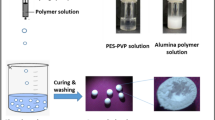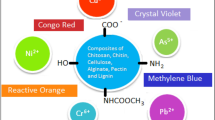Abstract
Poly(cyclotriphosphazene-co-4,4′-diaminodiphenyl ether) crosslinked microspheres with active amino groups on the surface were prepared by one-step precipitation polymerization method. The as-prepared material were characterized by means of FTIR, XPS, XRD, EDS and SEM. The effects of pH, time of contact, dosage, initial concentration and temperature on the adsorption of uranium(VI) by the crosslinked microspheres were studied, and the adsorption mechanism was elucidated. Under the optimized adsorption conditions, the adsorption removal efficiency reached 97.03%. The experimental results fit the Langmuir isotherm model and adsorption processes comply with the pseudo-second-order kinetic model. Thermodynamic data revealed that the adsorption behavior of uranium(VI) on the microspheres was spontaneous and exothermic.
















Similar content being viewed by others
References
Yu S, Wang J, Song S, Sun K, Li J, Wang X, Chen Z, Wang X (2017) One-pot synthesis of graphene oxide and Ni–Al layered double hydroxides nanocomposites for the efficient removal of U(VI) from wastewater. Sci China Chem 60(3):415–422
Sun Y, Wu Z-Y, Wang X, Ding C, Cheng W, Yu S-H, Wang X (2016) Macroscopic and microscopic investigation of U(VI) and Eu(III) adsorption on carbonaceous nanofibers. Environ Sci Technol 50(8):4459–4467
Zou Y, Liu Y, Wang X, Sheng G, Wang S, Ai Y, Ji Y, Liu Y, Hayat T, Wang X (2017) Glycerol-modified binary layered double hydroxide nanocomposites for uranium immobilization via extended X-ray absorption fine structure technique and density functional theory calculation. ACS Sustain Chem Eng 5(4):3583–3595
Duster TA, Szymanowski JES, Fein JB (2017) Experimental measurements and surface complexation modeling of U(VI) adsorption onto multilayered graphene oxide: the importance of adsorbate-adsorbent ratios. Environ Sci Technol 51(15):8510–8518
Wu P, Hwang K, Lan T, Lu Y (2013) A DNAzyme-gold nanoparticle probe for uranyl ion in living cells. J Am Chem Soc 135(14):5254–5257
Barillet S, Adam-Guillermin C, Palluel O, Porcher J-M, Devaux A (2011) Uranium bioaccumulation and biological disorders induced in zebrafish (Danio rerio) after a depleted uranium waterborne exposure. Environ Pollut 159(2):495–502
Wu Y, Pang H, Yao W, Wang X, Yu S, Yu Z, Wang X (2018) Synthesis of rod-like metal-organic framework (MOF-5) nanomaterial for efficient removal of U(VI): batch experiments and spectroscopy study. Sci Bull 63(13):831–839
Martins CA, Scheffler GL, Pozebon D (2016) Straightforward determination of U, Th, and Hf at trace levels using ultrasonic nebulization and axial view ICP OES. Anal Methods 8(3):504–509
He S, He J, Chen Q, Dang Y, Song H (2013) Characterization of electrodeposited uranium targets. J Radioanal Nucl Chem 295(3):1769–1774
Harrison JJ, Zawadzki A, Chisari R, Wong HKY (2011) Separation and measurement of thorium, plutonium, americium, uranium and strontium in environmental matrices. J Environ Radioact 102(10):896–900
Landstetter C, Damberger V, Zapletal M, Katzlberger C (2015) Development of a rapid method to determine plutonium in foodstuffs. J Radioanal Nucl Chem 304(1):343–347
Ding C, Cheng W, Jin Z, Sun Y (2015) Plasma synthesis of beta-cyclodextrin/Al(OH)3 composites as adsorbents for removal of UO22+ from aqueous solutions. J Mol Liq 207:224–230
Zhou L, Wang Y, Zou H, Liang X, Zeng K, Liu Z, Adesina AA (2016) Biosorption characteristics of uranium(VI) and thorium(IV) ions from aqueous solution using CaCl2-modified Giant Kelp biomass. J Radioanal Nucl Chem 307(1):635–644
Shen J, Schaefer A (2014) Removal of fluoride and uranium by nanofiltration and reverse osmosis: a review. Chemosphere 117:679–691
Chouyyok W, Wamer CL, Mackie KE, Warner MG, Gill GA, Addleman RS (2016) Nanostructured metal oxide sorbents for the collection and recovery of uranium from seawater. Ind Eng Chem Res 55(15):4195–4207
Bayramoglu G, Arica MY (2019) Star type polymer grafted and polyamidoxime modified silica coated-magnetic particles for adsorption of U(VI) ions from solution. Chem Eng Res Des 147:146–159
Bayramoglu G, Akbulut A, Acikgoz-Erkaya I, Arica MY (2018) Uranium sorption by native and nitrilotriacetate-modified Bangia atropurpurea biomass: kinetics and thermodynamics. J Appl Phycol 30(1):649–661
Bayramoglu G, Arica MY (2017) Polyethylenimine and tris(2-aminoethyl)amine modified p(GA-EGMA) microbeads for sorption of uranium ions: equilibrium, kinetic and thermodynamic studies. J Radioanal Nucl Chem 312(2):293–303
Arica MY, Bayramoglu G (2016) Polyaniline coated magnetic carboxymethylcellulose beads for selective removal of uranium ions from aqueous solution. J Radioanal Nucl Chem 310(2):711–724
Li P, Wang J, Wang X, He B, Pan D, Liang J, Wang F, Fan Q (2018) Arsenazo-functionalized magnetic carbon composite for uranium(VI) removal from aqueous solution. J Mol Liq 269:441–449
Qiu S, Ma C, Wang X, Zhou X, Feng X, Yuen RKK, Hu Y (2018) Melamine-containing polyphosphazene wrapped ammonium polyphosphate: a novel multifunctional organic-inorganic hybrid flame retardant.J. Hazard Mater 344:839–848
Ullah RS, Wang L, Yu H, Haroon M, Elshaarani T, K-u-R Naveed, Fahad S, Khan A, Nazir A, Xia X, Teng L (2019) Synthesis of polyphosphazene and preparation of microspheres from polyphosphazene blends with PMMA for drug combination therapy. J Mater Sci 54(1):745–764
Fu J, Wang S, Zhu J, Wang K, Gao M, Wang X, Xu Q (2018) Au–Ag bimetallic nanoparticles decorated multi-amino cyclophosphazene hybrid microspheres as enhanced activity catalysts for the reduction of 4-nitrophenol. Mater Chem Phys 207:315–324
Qiu S, Wang X, Yu B, Feng X, Mu X, Yuen RKK, Hu Y (2017) Flame-retardant-wrappedpolyphosphazene nanotubes: a novel strategy for enhancing the flame retardancy and smoke toxicity suppression of epoxy resins. J Hazard Mater 325:327–339
Luo T, Xu H, Li Z, Gao S, Ouadah A, Zhang Z, Zhang Y, Wang F, Jing C, Zhu C (2017) Novel proton conducting membranes from the combination of sulfonated polymers of polyetheretherketones and polyphosphazenes doped with sulfonated single-walled carbon nanotubes. Macromol Mater Eng 302(7):1700095
Hong S, Li J, Huang X, Liu H (2018) A facile approach to generate cross-linked poly(cyclotriphosphazene-co-oxyresveratrol) nanoparticle with intrinsically fluorescence. J Inorg Organomet Polym Mater 28(6):2258–2263
Zhang P, Huang X, Fu H, Huang Y, Zhu Y, Tang X (2009) A one-pot approach to novel cross-linked polyphosphazene microspheres with active amino groups. Macromol Chem Phys 210(9):792–798
Abdi S, Nasiri M, Mesbahi A, Khani MH (2017) Investigation of uranium(VI) adsorption by polypyrrole. J Hazard Mater 332:132–139
Anirudhan TS, Lekshmi GS, Shainy F (2019) Synthesis and characterization of amidoxime modified chitosan/bentonite composite for the adsorptive removal and recovery of uranium from seawater. J Colloid Interface Sci 534:248–261
Sprynskyy M, Kowalkowski T, Tutu H, Cukrowska EM, Buszewski B (2011) Adsorption performance of talc for uranium removal from aqueous solution. Chem Eng J 171(3):1185–1193
Langeroodi NS, Safaei E (2016) Carbonized medlar-core particles as a new biosorbent for removal of Cu2+ from aqueous solution and study of its surface morphology. Water Sci Technol 74(1):236–245
Belgacem A, Rebiai R, Hadoun H, Khemaissia S, Belmedani M (2014) The removal of uranium(VI) from aqueous solutions onto activated carbon developed from grinded used tire. Environ Sci Pollut Res 21(1):684–694
Xu C, Wang J, Yang T, Chen X, Liu X, Ding X (2015) Adsorption of uranium by amidoximated chitosan-grafted polyacrylonitrile, using response surface methodology. Carbohyd Polym 121:79–85
Schindler M, Hawthorne FC, Freund MS, Burns PC (2009) XPS spectra of uranyl minerals and synthetic uranyl compounds. I: the U 4f spectrum. Geochimica Et Cosmochim Acta 73(9):2471–2487
Li Z, Wang G, Ren W, Zhang A, An L, Tian Y (2016) Cyclotriphosphazene-containing polymeric nanotubes: synthesis, properties, and formation mechanism. J Mater Sci 51(8):4096–4103
Chung J, Chun J, Lee J, Lee SH, Lee YJ, Hong SW (2012) Sorption of Pb(II) and Cu(II) onto multi-amine grafted mesoporous silica embedded with nano-magnetite: effects of steric factors. J Hazard Mater 239:183–191
Fan F, Ding H, Bai J, Wu X, Lei F, Tian W, Wang Y, Qin Z (2011) Sorption of uranium(VI) from aqueous solution onto magnesium silicate hollow spheres. J Radioanal Nucl Chem 289(2):367–374
Peng GW, Ding DX, Xiao FZ, Wang XL, Hun N, Wang YD, Dai YM, Cao Z (2014) Adsorption of uranium ions from aqueous solution by amine-group functionalized magnetic Fe3O4 nanoparticle. J Radioanal Nucl Chem 301(3):781–788
Mezaguer M, Kamel NEH, Lounici H, Kamel Z (2013) Characterization and properties of Pleurotus mutilus fungal biomass as adsorbent of the removal of uranium(VI) from uranium leachate. J Radioanal Nucl Chem 295(1):393–403
Gavrilescu M, Pavel LV, Cretescu I (2009) Characterization and remediation of soils contaminated with uranium. J Hazard Mater 163(2–3):475–510
Giri AK, Patel RK, Mahapatra SS (2011) Artificial neural network (ANN) approach for modelling of arsenic(III) biosorption from aqueous solution by living cells of Bacillus cereus biomass. Chem Eng J 178:15–25
Kumar R, Bishnoi NR, Garima Bishnoi K (2008) Biosorption of chromium(VI) from aqueous solution and electroplating wastewater using fungal biomass. Chem Eng J 135(3):202–208
Mahmoud MR, Soliman MA, Allan KF (2015) Adsorption behavior of samarium(III) from aqueous solutions onto PAN@SDS core-shell polymeric adsorbent. Radiochim Acta 103(6):443–456
Wang J-s, Hu X-j, Liu Y-g, Xie S-b, Bao Z-l (2010) Biosorption of uranium(VI) by immobilized Aspergillus fumigatus beads. J Environ Radioact 101(6):504–508
Zhang Z-b, Cao X-h, Liang P, Liu Y-h (2013) Adsorption of uranium from aqueous solution using biochar produced by hydrothermal carbonization. J Radioanal Nucl Chem 295(2):1201–1208
Arica TA, Kuman M, Gercel O, Ayas E (2019) Poly(dopamine) grafted bio-silica composite with tetraethylenepentamine ligands for enhanced adsorption of pollutants. Chem Eng Res Des 141:317–327
Kishor P, Sengupta A, Adya VC, Salvi NA (2017) Highly efficient bio-sorption of trivalent f-elements using wild type Rhizopus arrhizus dead fungus. J Radioanal Nucl Chem 312(2):395–403
Kuncham K, Nair S, Durani S, Bose R (2017) Efficient removal of uranium(VI) from aqueous medium using ceria nanocrystals: an adsorption behavioural study. J Radioanal Nucl Chem 313(1):101–112
Malkoc E, Nuhoglu Y (2005) Investigations of nickel(II) removal from aqueous solutions using tea factory waste. J Hazard Mater 127(1–3):120–128
Liu M, Wang Y, Ma Z, Luo Y (2019) Poly (cyclotriphosphazene-co-phloroglucinol) PCPP as a solid phase extractant for preconcentrative separation of uranium (VI) from aqueous Solution. J Radioanal Nucl Chem 319(1):279–288
Mellah A, Chegrouche S, Barkat M (2006) The removal of uranium(VI) from aqueous solutions onto activated carbon: kinetic and thermodynamic investigations. J Colloid Interface Sci 296(2):434–441
Tan J, Wang Y, Liu N, Liu M (2018) Adsorption of uranium (VI) from aqueous solution by tetraphenylimidodiphosphinate. J Radioanal Nucl Chem 315(2):119–126
Wang X, Liu Q, Liu J, Chen R, Zhang H, Li R, Li Z, Wang J (2017) 3D self-assembly polyethyleneimine modified graphene oxide hydrogel for the extraction of uranium from aqueous solution. Appl Surf Sci 426:1063–1074
Dake LS, Baer DR, Ferris KF, Friedrich DM (1990) Ligand and structure effects on the N–P bonds of phosphazenes. J Electron Spectrosc Relat Phenom 51:439–457
Zeng J, Zhang H, Sui Y, Hu N, Ding D, Wang F, Xue J, Wang Y (2017) New amidoxime-based material TMP-g-AO for uranium adsorption under seawater conditions. Ind Eng Chem Res 56(17):5021–5032
Yang D, Wang X, Wang N, Zhao G, Song G, Chen D, Liang Y, Wen T, Wang H, Hayat T, Alsaedi A, Wang X, Wang S (2018) In-situ growth of hierarchical layered double hydroxide on polydopamine-encapsulated hollow Fe3O4 microspheres for efficient removal and recovery of U(VI). J Clean Prod 172:2033–2044
Pang H, Huang S, Wu Y, Yang D, Wang X, Yu S, Chen Z, Alsaedi A, Hayat T, Wang X (2018) Efficient elimination of U(VI) by polyethyleneimine-decorated fly ash. Inorg Chem Front 5(10):2399–2407
Li J, Wang X, Zhao G, Chen C, Chai Z, Alsaedi A, Hayat T, Wang X (2018) Metal-organic framework-based materials: superior adsorbents for the capture of toxic and radioactive metal ions. Chem Soc Rev 47(7):2322–2356
Yin L, Song S, Wang X, Niu F, Ma R, Yu S, Wen T, Chen Y, Hayat T, Alsaedi A, Wang X (2018) Rationally designed core-shell and yolk-shell magnetic titanate nanosheets for efficient U(VI) adsorption performance. Environ Pollut 238:725–738
Author information
Authors and Affiliations
Corresponding author
Additional information
Publisher's Note
Springer Nature remains neutral with regard to jurisdictional claims in published maps and institutional affiliations.
Rights and permissions
About this article
Cite this article
Ma, Z., Wang, Y., Liu, M. et al. Highly efficient uranium(VI) removal from aqueous solution using poly(cyclotriphosphazene-co-4,4′-diaminodiphenyl-ether) crosslinked microspheres. J Radioanal Nucl Chem 321, 1093–1107 (2019). https://doi.org/10.1007/s10967-019-06681-9
Received:
Published:
Issue Date:
DOI: https://doi.org/10.1007/s10967-019-06681-9




